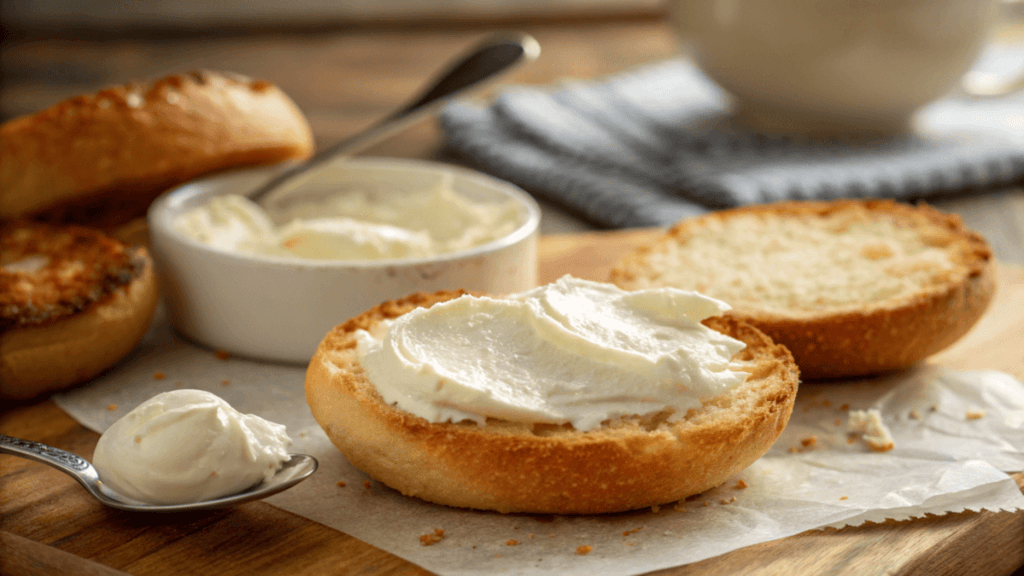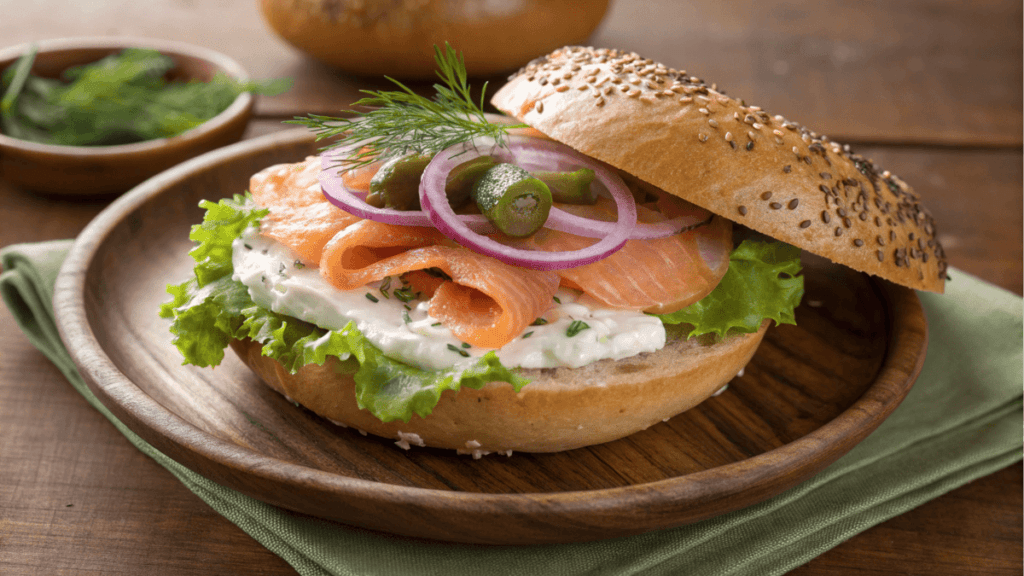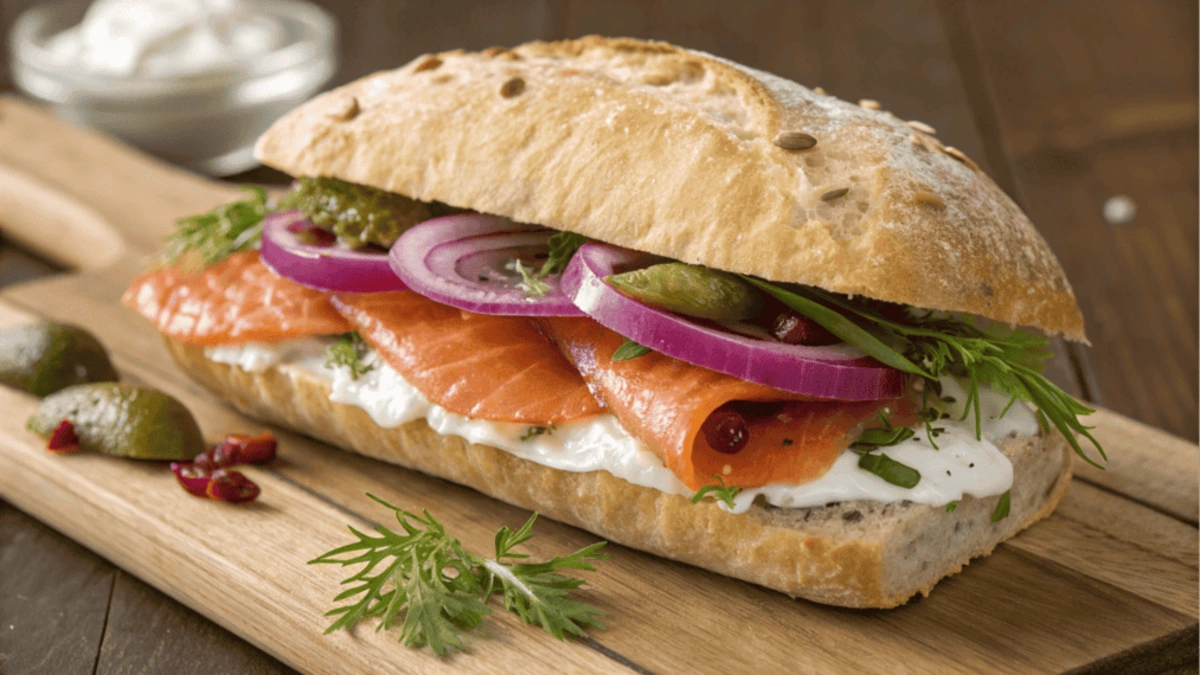Matjesbrötchen, a delightful sandwich crafted with tender pickled herring, fresh bread, and vibrant toppings, is a beloved staple of German cuisine. This article dives deep into the matjesbrötchen recipe, exploring its health benefits, historical roots, regional variations, and the secrets to crafting the perfect version at home. Whether you’re a fan of traditional seafood recipes or just looking for a unique dish to try, this guide will help you master this flavorful classic.
Introduction to Matjesbrötchen
What is Matjesbrötchen?
Matjesbrötchen, often called the “herring sandwich,” is a German seafood delicacy that’s simple yet bursting with flavor. It features pickled matjes herring, a type of young, tender fish known for its mild, slightly sweet taste. Typically, the fish is nestled in a crusty bread roll and topped with ingredients like onions, lettuce, and a creamy spread.
Furthermore, this sandwich has become a go-to meal for those who crave a quick, healthy, and delicious bite. It’s portable, versatile, and packed with protein, making it perfect for lunch, a light dinner, or even as a party appetizer.
Why is it a German Classic?
Germany’s deep connection to the sea is reflected in dishes like the matjesbrötchen recipe. Specifically, originating in Northern Germany, this sandwich became popular in port cities like Hamburg, where fishermen paired fresh matjes with bread for a hearty, on-the-go meal. Over time, its appeal gradually spread across the country and beyond, turning it into a cultural symbol of German culinary traditions.
Global Popularity and Versatility
In recent years, the matjesbrötchen recipe has gained international recognition. Its unique combination of flavors and simplicity resonates with foodies worldwide. Whether served at German festivals, in trendy seafood restaurants, or recreated at home, matjesbrötchen is an unforgettable culinary experience. Plus, its adaptability makes it easy to customize for different tastes or dietary needs.
With its blend of tradition, taste, and nutrition, matjesbrötchen is much more than a sandwich—it’s a little piece of Germany on your plate.
Health Benefits of Matjesbrötchen Recipe
Nutritional Value of Matjes
The matjesbrötchen recipe isn’t just about taste—it’s a powerhouse of nutrition. Matjes, the star ingredient, is packed with omega-3 fatty acids, which are known to boost heart health and brain function. This fish also offers a generous dose of protein, making it ideal for anyone seeking a satisfying yet wholesome meal.
Besides the herring, the toppings and bread contribute essential nutrients. Whole-grain bread provides fiber, while fresh greens and creamy spreads offer vitamins and minerals that support overall health.
Nutritional Breakdown of Matjesbrötchen
| Nutrient | Amount Per Serving (Approx.) |
|---|---|
| Calories | 320 kcal |
| Protein | 17 g |
| Total Fat | 15 g |
| Carbohydrates | 28 g |
| Fiber | 3 g |
| Sugars | 3 g |
| Vitamin A | 650 IU |
| Vitamin C | 4 mg |
| Calcium | 80 mg |
| Omega-3 Fatty Acids | 1.5 g |
Role of Omega-3s and Protein
Why is omega-3 so important? These healthy fats reduce inflammation, lower cholesterol, and improve cardiovascular health. Combined with the high-quality protein in matjes, this sandwich becomes a nutritious choice for active lifestyles. Whether you’re fueling up for the day or recovering after a workout, the matjesbrötchen recipe can fit right into your plan.
Balanced Meal Components
The best part? This recipe combines all the key components of a balanced meal. It provides lean protein, healthy fats, and carbohydrates in every bite. Add vibrant toppings like lettuce and onions, and you’re also packing in antioxidants. The matjesbrötchen recipe isn’t just a treat—it’s a meal you can feel good about eating.
History and Cultural Significance
Origins in Northern Germany
The matjesbrötchen recipe traces its roots to the bustling port cities of Northern Germany, where fresh seafood was a way of life. Fishermen in Hamburg and beyond would prepare matjes sandwiches as a quick, portable meal during long days on the water. Over time, these humble sandwiches became a beloved tradition, celebrated for their simplicity and flavor.
Matjesfest and Local Traditions
Ever heard of Matjesfest? This annual festival in Emden, Germany, is a testament to the cultural significance of matjes. Specifically, thousands gather to honor this delicacy, enjoying it in various forms, including the classic matjesbrötchen recipe. Moreover, it’s a time for locals and visitors to connect over a shared love for seafood and tradition.
How It Connects to German Heritage
The matjesbrötchen recipe isn’t just food—it’s a piece of history that reflects Germany’s maritime heritage. Furthermore, the sandwich embodies the resourcefulness of coastal communities, where simple ingredients like bread and herring were transformed into something extraordinary. Indeed, each bite tells a story of tradition, innovation, and the enduring appeal of authentic German cuisine.
Moreover, from its origins as a fisherman’s staple to its role in modern-day celebrations, the matjesbrötchen recipe remains a symbol of connection and culture. Whether you’re in Hamburg or hosting a German-themed gathering at home, this sandwich is a delicious way to honor the past while savoring the present.
Essential Ingredients for the Perfect Matjesbrötchen Recipe
How to Choose the Best Matjes for Your Recipe
The heart of any matjesbrötchen recipe is the matjes herring. Opt for high-quality fillets that are tender, slightly sweet, and mild in flavor. Avoid anything overly salty or fishy, as these can overpower the sandwich. Look for labels such as “MSC Certified” to ensure your matjes is sustainably sourced.
For a unique twist, experiment with smoked herring or flavored matjes varieties like dill or mustard for added depth.
The Role of Bread in the Matjesbrötchen Recipe
Bread is the foundation of the matjesbrötchen recipe, so choosing the right type is essential. Traditional options include Kaiser rolls or fresh crusty baguettes. Whole-grain rolls add a hearty texture, while gluten-free alternatives ensure inclusivity for those with dietary needs.
To elevate the experience, lightly toast the bread before assembling the sandwich. This simple step prevents sogginess and adds a delightful crunch.
Must-Have Toppings and Garnishes
The toppings can make or break your sandwich, so choosing the right ones is essential. Classic options include thinly sliced red onions, crisp lettuce, and sour cream or crème fraîche. Additionally, for a pop of flavor, consider adding pickles, dill, or a dollop of horseradish sauce. Ultimately, these garnishes complement the matjes’ tangy taste perfectly, elevating your sandwich to a whole new level of deliciousness.
Ingredient Sourcing Tips for the U.S.
Finding authentic ingredients might seem tricky, but specialty European markets or online retailers like GermanDeli.com are excellent resources. If matjes is unavailable, smoked salmon or marinated mackerel are great substitutes. Don’t forget to prioritize freshness—it makes all the difference!
Step-by-Step Guide to the Matjesbrötchen Recipe
Preparing the Bread and Base for Matjesbrötchen Recipe
Start your matjesbrötchen recipe by choosing the freshest bread possible. Kaiser rolls, baguettes, or whole-grain buns work wonderfully. For an extra touch, lightly toast the bread to create a crispy texture that complements the softness of the matjes. Once toasted, spread a generous layer of sour cream or crème fraîche on the bottom half. This creamy base not only adds tanginess but also prevents the bread from becoming soggy.

For a zingy twist, mix your sour cream with a bit of lemon juice or mustard before spreading.
Arranging the Matjes and Toppings
The matjes fillets are the hero of this recipe, so handle them with care. Lay 2–3 fillets evenly across the bread, ensuring full coverage. Pat the fillets dry before assembling to avoid excess moisture. Next, layer on thin slices of red onion, crisp lettuce leaves, or fresh dill sprigs for a burst of flavor and texture.
If you’re feeling adventurous, try adding pickles or a drizzle of horseradish sauce for an added kick.

Assembling the Sandwich
Once the toppings are in place, close the sandwich with the top half of the bread. Press gently to hold everything together without squishing the ingredients. Serve immediately to enjoy the full range of flavors at their freshest.
Pro Tips for a Perfect Matjesbrötchen
- Keep it simple: Don’t overload the sandwich with too many toppings; the matjes should shine.
- Play with flavors: Add a sprinkle of smoked paprika or lemon zest for a gourmet touch.
- Serve fresh: Assemble the sandwich just before eating to maintain the bread’s texture.
Common Issues and Fixes for the Matjesbrötchen Recipe
Preventing Soggy Bread
A common pitfall in the matjesbrötchen recipe is soggy bread. To avoid this, always pat your matjes fillets dry with a paper towel before placing them on the bread. Additionally, using toasted bread creates a barrier that helps keep moisture at bay.
Managing Overly Salty Matjes
Sometimes matjes can be too salty. If this happens, soak the fillets in cold water or milk for 15–30 minutes to reduce the saltiness. This quick fix ensures your sandwich remains balanced and delicious.
Substitutes for Matjes in the Matjesbrötchen Recipe
No matjes? No problem! Substitute with smoked salmon, marinated mackerel, or even canned sardines. While the flavor profile will differ slightly, these alternatives still create a satisfying seafood sandwich that pays homage to the matjesbrötchen recipe.
Creative Serving and Presentation Ideas
DIY Matjesbrötchen Recipe Bar for Parties
If you’re hosting a party or casual get-together, why not set up a DIY matjesbrötchen recipe bar? Arrange various breads, toppings, and garnishes so guests can customize their sandwiches. Include options like flavored sour creams, spicy horseradish, or even tangy chutneys for an exciting mix of flavors. This interactive setup is not only fun but also allows everyone to tailor their sandwich to their liking.
Pair the DIY bar with a few sides, like cucumber salad or German potato salad, to complete the meal.
Mini Matjesbrötchen Recipe for Appetizers
Want to serve matjesbrötchen as an appetizer? Instead, opt for smaller bread rolls or cut larger baguettes into bite-sized portions. Then, secure each mini sandwich with decorative toothpicks, and arrange them on a platter with lemon slices and fresh dill as garnishes. Ultimately, this bite-sized version is perfect for events where finger foods are preferred.
Garnishes to Elevate Your Matjesbrötchen Recipe
Presentation matters, especially when showcasing a dish as unique as the matjesbrötchen recipe. Sprinkle smoked paprika, add a sprig of dill, or place a lemon wedge on the side to create a visually appealing plate. Serving the sandwiches open-faced on rustic wooden boards can also add a touch of elegance.
Regional Variations and Modern Twists
Northern German Minimalist Approach
In Northern Germany, the matjesbrötchen recipe is often stripped back to basics. Specifically, it’s typically served with just matjes, onions, and butter on a fresh roll. This simple preparation highlights the natural flavors of the herring, thereby offering an authentic taste of German coastal cuisine.
Southern German Creamy Variations
In Southern Germany, you’ll find a creamier take on the classic. These versions often include dill sauce or mayonnaise-based spreads, adding a rich contrast to the tangy matjes. Pickled vegetables are also popular, offering a burst of tanginess in every bite.
International Adaptations
Outside Germany, the matjesbrötchen recipe has taken on a life of its own. Scandinavia pairs matjes with rye bread for a heartier texture, while the Netherlands incorporates sweet pickles. Even fusion variations, like pairing matjes with naan bread or spicy aioli, show the dish’s versatility.
For more seafood inspiration, check out the Seared Ahi Tuna Recipe on Absolut Recipes.
FAQs About Matjesbrötchen Recipe
Can I Make It Gluten-Free?
Yes! The matjesbrötchen recipe is easy to adapt for gluten-free diets. Substitute the bread with gluten-free rolls or even lettuce wraps for a fresh, light alternative.
What is the recipe for the Coaltana?
The Coaltana is a cocktail crafted for smoky and citrusy flavor lovers. To begin, combine 2 oz of mezcal, 1 oz of fresh lime juice, 0.75 oz of agave syrup, and a splash of activated charcoal for its signature black hue. Then, shake all ingredients with ice and strain into a chilled coupe glass. Additionally, garnish with a lime wheel or a twist of orange peel for a bright finish. Ultimately, this drink offers a bold, smoky taste with a visually striking appearance!
What is the thunderbrew recipe?
The Thunderbrew is a fictional ale inspired by fantasy lore, often recreated as a spiced beverage. To craft this delightful drink, begin by mixing 12 oz of dark beer, 2 oz of spiced rum, 1 tbsp of honey, and a pinch of cinnamon. Next, gently heat the mixture until it’s warm but not boiling, ensuring the flavors meld harmoniously. Finally, serve it in a sturdy mug, garnished with a cinnamon stick for extra flair. Ultimately, this drink is perfect for a cozy evening or themed gatherings, offering a touch of magic to any occasion!
What is the recipe for Mangria?
The Mangria, a bold and flavorful blend of sangria and spirits, is an ideal choice for festive gatherings. To prepare, mix 1 bottle of red wine, 1 cup of vodka, and 1 cup of orange juice in a large pitcher. Then, add sliced oranges, lemons, and berries for a fruity twist. Afterward, chill the mixture for a few hours to let the flavors meld. Finally, serve over ice for a refreshing cocktail. Ultimately, this punchy drink is perfect for parties or casual get-togethers, bringing a lively vibe to any occasion!
What is Dominican mangu made of?
Dominican Mangú is made primarily from boiled green plantains. The plantains are peeled, boiled until soft, and then mashed with butter, olive oil, or a splash of the cooking water to achieve a creamy consistency. It’s traditionally served with red onions sautéed in vinegar, alongside sides like fried cheese, salami, or eggs, making it a staple breakfast dish in the Dominican Republic known as “Los Tres Golpes.”
For more inspiration, check out our Roasted Red Pepper Gouda Soup recipe, which pairs beautifully with seafood dishes like matjesbrötchen!
Conclusion and Call to Action
Why You Should Try the Matjesbrötchen Recipe
The matjesbrötchen recipe is more than just a sandwich—it’s a delightful blend of German tradition, robust flavors, and culinary creativity. Furthermore, from its nutritional benefits to its rich cultural history, this dish has something for everyone. Additionally, its versatility allows for endless customization, making it a standout option for meals, snacks, or gatherings.
Share Your Matjesbrötchen Recipe Creations
Now it’s your turn to bring the matjesbrötchen recipe to life. For example, you can experiment with various toppings to suit your taste. Additionally, adapt the recipe for dietary needs, ensuring it works for everyone at your table. If you have a unique twist on the recipe, share your story and inspire others. Together, let’s keep this cherished tradition alive and thriving!

